Top News

May 6, 2014 Ken Sasaki of Ryukyu Shimpo
An Okinawa resident and game creator Ryo Agarie has co-developed a top-ranking smartphone game app, working from his home in Naha. Since it was sold this February, the Japanese-mythology themed puzzle game is currently first place out of 19 countries in App Store rankings. It is also ranked top in the Puzzle Game category.
Tengami is an adventure game full of Japanese scenery and imagery.
Using a background of traditional Japanese paper, they designed classical Japanese scenes such as temple grounds, and a flurry of falling cherry blossoms.
These were inspired by Japanese mythology. Game users from all around the world are hooked on the game’s beautifully crafted pop-up book world built in Tengami. Users range from children to elderly people.
Originally from Aichi Prefecture, Agarie went to college in the United Kingdom. After graduating, he started working for major British video game developer Rare Ltd. There, Agarie created characters for an online multiplayer gaming and digital media delivery service Xbox Live. After leaving the company in 2012, Agarie returned home to Japan. His work was destined to come to Okinawa, after he met his Okinawan wife-to-be Riko at college in the United Kingdom.
After moving to Okinawa to raise a family with his wife, he began co-developing Tengami for an independent game developer Nyamyam, which was formed by his former co-workers at Rare.
He worked on the project as part of a team with two main co-developers British Phil Tossell and German Jennifer Schneidereit. Agarie’s wife Riko also assisted with the graphics.
The team used a freemium voice-over-IP service and instant messaging client Skype to keep in regular contact during the game’s development. They held conferences every morning at 8:00 a.m.
Agarie said the game industry is redefining creative collaboration through the internet.
“With improved the infrastructure of the internet, people can work anywhere,” he said.
Agarie went on to say, “I chose Okinawa as a workplace because Okinawa is my wife’s home with a beautiful sea where her parents help us raise our children.”
Agarie actively works on promoting exchanges between game developers who work internationally. He has set up a website where developers and media companies can share information. The site acts as a bridge between the developers that want to promote independent video games, and media companies.
“A connection is important in the game industry because workers have their own roles for developing games. If connected, people can work anywhere,” he said.
Agarie will continue to develop independent video games for a world audience from Okinawa.
(English translation by T&CT)
Go to Japanese
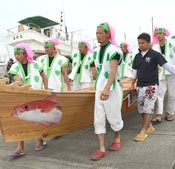
May 2, 2014 Ryukyu Shimpo
A launching ceremony for three dragon boats built last October was held on April 27 at Itoman Fishing Port. Young people from Nishimura, Nakamura, and Niijima districts – Itoman’s long-established communities – poured rice and sacred sake on the boats in keeping with the old ways. After that, they launched the new boats in the sea. The boats will be used for Agaisubu race, which is a highlight of the Itoman dragon boat festival held on the 1st of June.
It takes one year to complete the new boats in Itoman. Each community has its own symbol. A dragon is painted on the Nishimura boat, a ruby snapper on the Nakamura boat and a marlin on the Niijima boat.

On April 27, young people row new harii boat at the launching ceremony at the Itoman Fishing Port.
After launching the boats, the young people carried out a test ride in the port area and beyond it, confirming the safety and ride quality of the boats.
Masatsugu Uehara from Nishimura team said, “I felt refreshed, and it encouraged us to practice for the real race. We want to achieve the second straight win.”
After the ceremony, young people reported the boat completion to ancestors at the Hakugin-do temple and offered sacred sake.
(English translation by T&CT, Hitomi Shinzato)
Go to Japanese

May 6, 2014 Ryukyu Shimpo
A Ryukyu glass company Rurian has begun selling its jewelry brand products at a select shop in Singapore as of the start of May. The company is working to sell its products in overseas markets with support from the Okinawa Industry Promotion Public Corporation. Rurian started selling its brand jewelry at two stores in Hong Kong last year.
The company’s Ryukyu glass jewelry is all handmade. It takes orders for custom-made products. The products are on sale at T Galleria Okinawa, the Rurian shop in the Naha Airport international terminal, and at the Joia De Lequios at Oyama, Ginowan.
Yoshino Inamine, the managing director of the company who designs a part of the products, said, “I am excited and nervous at the same time. I have no idea what reaction we will get from Singapore, but we want to sell our ryukyu glass jewelry.”
For further information, please contact Joia De Lequios Telephone: 098 (943) 0738.
(English translation by T&CT)
Go to Japanese
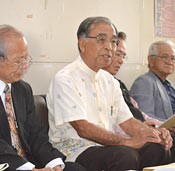
May 1, 2014 Ryukyu Shimpo
On April 30, a citizen group opposing an amendment to the Constitution of Japan that would allow the pacifist nation to have its own military again, held a press conference at the Okinawa Prefectural Government Office. They criticised plans to revise the constitution, arguing “It takes the teeth out of the constitution.” Shoei Asato, a co-caretaker of the association said, “If we are not careful, Okinawa will become a battlefield and Okinawan people will die again.”
The group expressed their concerns in their statement, referring to moving U.S. Marine Corps Futenma Air Station to Henoko in Nago and stationing the Japan Self-Defense Forces in Yonaguni. One of the group members said, “Military bases in Okinawa will be reinforced as the front-line bases against China. We fear that Okinawa will become a battlefield in a war between China and Japan.” The other said, “We have to voice our protests against the movement of the Abe administration pushing to use the right of collective defense, which will change Japan to a nation that can wage war.”
Another co-caretaker of the group Morihisa Higa stated, “We should set up relations with Asian nations, including China by peace diplomacy, not military power.”
(English translation by T&CT and Lima Tokumori)
Go to Japanese
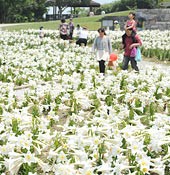
May 5, 2014 Ryukyu Shimpo
In the solar calendar of East Asian cultures, May 5 or “Lixia” marks the beginning of Summer. The season was ushered in with the blooming of 60,000 Easter lilies at Okinawa Comprehensive Athletic Park in Okinawa City.
Many families viewed the lillies while visiting the park for the Golden Week holidays.
Miyazato Elementary School pupil Reira Higa, who visited with her parents, said, “Many flowers were in full bloom and beautiful. I enjoyed the sweet smell of the flower.”
The lily reached full bloom at the end of April, and will continue to be until this weekend.
Park staff Eriko Kina said, “I would like many people to visit the park.”
(English translation by T&CT)
Go to Japanese
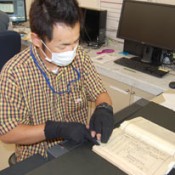
April 30, 2014 Yoshiya Hokama of Ryukyu Shimpo
The Okinawa Prefectural Government (OPG) has been working on a project to digitize the official documents created by the Government of the Ryukyu Islands during the American occupation. The OPG plans to release them on the website of the Okinawa Prefectural Archives.
In order to preserve historically valuable documents, it will start to release some of the documents from next April.
Using state subsidies for software projects, the government plans to continue the work into the 2021 fiscal year.
The archival institution currently preserves about 160,000 of the Ryukyu government documents. Among them, about 130,000 can be digitized. Each of the documents has several dozen to several hundred pages. The total number of pages amounts to more than 10 million.
The OPG assigned 16 million yen under supplemental budgets in fiscal 2013 for the project. It has digitized 2,000 documents.
The government has assigned 67 million yen for the project in fiscal 2014, planning to digitize 11,000 documents from the Ryukyu administration office.
These documents contain the letters exchanged between the Ryukyu government and the United States Civil Administration of the Ryukyu Islands (USCAR), documents related to the Agreement between Japan and the United States of America concerning the Ryukyu Islands and the Daito Islands, request documents sent to the Japanese and the U.S. governments, and documents related to the removal of chemical weapons from Okinawa.
In the digitization process, staff take photographs of individual document pages and store them. By automating a part of the digitization, the staff aim to streamline the work and cut costs. They claim that they can store the documents with high image quality.
Takehiko Oshiro of the OPG said, “The Ryukyu government documents are accessible only at the archival institution. With the digitization, I would like many people to access them.”
(English translation by T&CT)
Go to Japanese
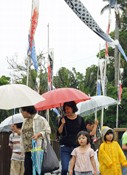
May 6, 2014 Ryukyu Shimpo
On May 5, the Okinawa Meteorological Observatory announced the beginning of the rainy season in Okinawa.
It started four days earlier than average years and five days earlier than last year.
Due to the seasonal rain front, the state of the atmosphere in the mainland of Okinawa and Sakishima Islands is unstable, which means sudden changes in weather are more likely.
Okinawa Islands experienced heavy rainfall from the morning of May 5. In particular, Ishigaki City had its highest heavy rainfall in 50 years. In the Moriyama district of Ishigaki, the precipitation was 209.5 millimeters for a period of three hours, which is the highest recorded. In Kitahara district of Kumejima Island, the precipitation stayed at 89 millimeters for three hours and 64.5 millimeters for an hour. These figures were the highest recorded in May.
The observatory issued a flood warning for Ishigaki City, Taketomi Town and Kumejima Town. It also issued a flood warning for the north-central areas of the mainland of Okinawa. The observatory then removed the warning around 2:30 p.m.
It expects a weather front and moist air current to bring cloudy and rainy days to the Okinawa region in the coming week. The rainy season usually ends around June 23.
(English translation by T&CT)
Go to Japanese
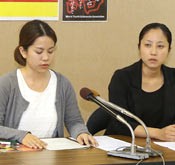
April 29, 2014 Ryukyu Shimpo
On April 28, Minami Tamamoto, the president of the World Youth Uchinanchu Association (WYUA) and Chiho Higa, the executive director of the WYUA Okinawa head office, held a press conference at the Okinawa Prefectural Office. They reported on the third World Youth Uchinanchu Festival Germany 2014 which will be held in Germany from July 30 to August 1.
They expect attendance of about 50 participants from the community of Okinawans living in Germany, France, and Italy, as well as young people with an interest in Okinawa. The association plans to hold exchanges, sending local college students to youth international conferences. They will give out brochures promoting the stories of successful Okinawans in Europe and the charms of Okinawa. Higa said, “University students in Okinawa and local coordinators have been focusing on preparing the event.” Tamamoto said, “For the 6th Worldwide Uchinanchu Festival, we would like to appeal to young people and encourage young generations to take over leading the events.”
(English translation by T&CT and Megumi Chibana)
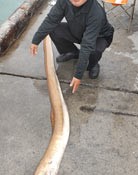
April 28, 2014 Ryukyu Shimpo
Ballroom dance instructor and hobby-fisherman Minoru Higa has caught a 2.7-meter long moray. He said of the catch, “It was a hard work.” Before being pulled in, it struggled to escape, and swam back and forth for 50 meters along the dock.
On the ground, the moray floundered, creating a clackety-clack noise that surprised the people gathered around.
A curious cat timidly approached. Higa’s friend Terukazu Taketomi said with a smile, “We can create dishes for 100 people from the moray. We will hold a banquet tonight.”
It was carved up at the scene.
(English translation by T&CT)
Go to Japanese
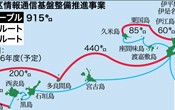
May 4, 2014 Kazuki Furugen of Ryukyu Shimpo
The Okinawa Prefecture Government (OPG) plans to lay about 915 kilometers of submarine optical cable to the remote islands from fiscal 2014 to fiscal 2016 in order to modernise communication tools such as the Internet. The cable will be connected between the main Island of Okinawa and its remote islands by August 2016. Residents living in islands near the main island of Okinawa, Miyako Islands and Yaeyama Islands, will be able to use advanced communications, at large capacity and low-cost. The OPG aims to attract telecommunications companies such as call centers to create jobs in the remote islands. It plans to use the loop cable system for the remote islands during possible disasters and emergencies such as earthquakes and typhoons.
The development of information and communication infrastructure has not advanced in the remote islands because laying cables is geographically difficult, and not highly profitable. Therefore, residents do not have access to ultra-high-speed communication, which is available on the main island of Okinawa. This adversely affects the economies of the remote island municipalities because they struggle to attract business.
The total project cost of laying cables is about 9.1 billion yen, of which the central government pays 80 percent as a lump-sum government subsidy for the promotion and development of Okinawa, and the OPG pays 20 percent.
By connecting new cable to an existing line, the rollout will form a loop between two districts such as the Sakishima loop, which includes Miyako and Yaeyama, and the Kumejima loop, which includes the islands around the southern part of the main Island of Okinawa.
The OPG also plans to lay the submarine optical cable to Yonaguni and Tarama Islands, where the residents use only radio communication. This project aims to raise the standard of remote island communication infrastructure to that of the urban area of the main Island. As it stands, if the cable between the main Island of Okinawa and Miyako fails anywhere, people are cut off from using telephone or Internet in large areas of Miyako and Yaeyama. By looping the cable, it is possible to prevent communication failures across the whole system, by providing backup and localising the failure to its source.
The officials of the OPG expect that the development of ultra-high-speed communication will contribute to education, healthcare and disaster prevention in the remote islands.
(English translation by T&CT)
Go to Japanese
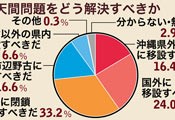
May 5, 2014 Ryukyu Shimpo
A telephone poll conducted in late April by the Ryukyu Shimpo showed only 16.6 percent of respondents supported the plan to move the U.S. Marine Corps Futenma Air Station in Ginowan to Henoko in Nago. The governments of Japan and the United States promote this plan. They do so despite widespread opposition, confirmed in the recent figures which showed 73.6 percent of respondents were opposed to relocating Futenma within the prefecture. This includes respondents who seek “unconditional closure and removal of the Futenma base.” The poll was conducted at the end of December last year after Okinawa Governor Hirokazu Nakaima approved the Henoko landfill after pledging not to allow it to be relocated within the prefecture. Two separate polls showed similar results, further validating the findings. Despite the governor’s approval of the landfill application, the Okinawan people’s opposition to the relocation within the prefecture remains strong.
Asked how to return the Futenma base site to Okinawa and how to solve the relocation issue, the most frequent responses were “The Futenma base should be closed and removed unconditionally”(33.2 percent). This was followed by “relocate the Futenma base outside Japan” (24.0 percent), and “relocate the Futema base to other prefectures” (16.4 percent).
“The Futenma base should be moved to Henoko,” was 16.6 percent and “move Futenma to other places besides Henoko” (6.6 percent). The stance of opposing the current Henoko relocation plan, which the governments are advancing, has reached 80 percent.
Regarding a question on the Senkaku Islands issue, which has worsened Japan-China relations, 70.5 percent of people answered that “Japan should watch the transition take place,” and “should settle this issue through negotiations.”
Only 27.9 percent of people answered that “Japan should keep strong stance.” The majority of Okinawan people seek a peaceful solution and cautious reaction despite the Abe administration’s tough stance on the Senkaku issue. On the other hand, 52.6 percent of the respondents supported the Abe Cabinet while 41.5 percent did not support it.
The method of the poll: On April 26 and 27, Ryukyu Shimpo carried out the opinion poll among voters who live in Okinawa using RDD (random digit dialing) method. The survey was conducted by automated telephone calls to the numbers that were generated randomly by computer. The advantage of RDD dialing is in reaching households with unlisted phone numbers. This method can achieve a high accuracy because the samples reflect the age and gender of the population of registered voters. In the survey, 1,068 households with eligible voters were contacted by phone, of whom 504 responded.
(English translation by T&CT)
Go to Japanese












 Webcam(Kokusai Street)
Webcam(Kokusai Street)


